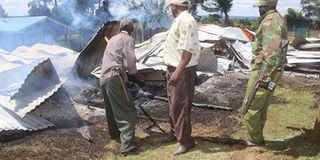Locals and leaders differ on cause of Narok violence

Houses burnt in Olangabei, Narok North, on September 24, 2018 following renewed clashes. PHOTO | AYUB MUIYURO | NATION MEDIA GROUP
What you need to know:
- The clashes between the Maasai and Kipsigis, which erupted on Sunday evening, have seen dozens of houses burnt leaving a trail of destruction.
- Narok County Commissioner George Natembeya believes the violence broke out due to cattle theft.
Sudden. This word appropriately describes the ethnic flare-ups in Olposimoru along the border of Nakuru and Narok counties that left one person dead and at least 32 others injured.
The clashes between the Maasai and Kipsigis, which erupted on Sunday evening, have seen dozens of houses burnt leaving a trail of destruction.
It first started as a cattle theft incident before it degenerated into full-blown ethnic violence that saw neighbouring communities, that have lived harmoniously, rise against each other.
"Some cattle were stolen from one community. Then members of the other community went after the stolen stock but were repulsed leading to intense fighting," Mr Alfred Sang, an elder, said.
According to sources, security teams were taken by surprise by the attack that has saw more than 30 homes set ablaze at Olmariko and Esoit areas in Narok North.
The clashes, according to former Olpusimoru MCA Wilson ole Masikonte, were triggered by the theft of seven cows in Olmariko.
EVICTIONS
Trading centres, stores and houses have been reduced to ashes and families left homeless in the violence.
In what is said to have been a spillover of clashes earlier witnessed in Narok and Nakuru, the clashes between the two communities are linked to a frightening dimension — land.
“There has been tension in these areas especially after the government announced that the evictions from the Mau Forest would be extended to Nakuru. The tension could be behind the violence,” Mr John Kuyo, a resident told the Nation.
The latest clashes come in the wake of similar violence in Nakuru between two communities that left at least six people dead and several nursing arrow injuries last week.
However, Narok County Commissioner George Natembeya believes the violence broke out due to cattle theft.
CONFLICT
Mr Natembeya said a decision by a group of more than 200 youth from Olenguruone to issue a two-hour ultimatum for the stolen animals to be returned is what may have caused the violence.
Mr James ole Kokot, a local at Olpusimoru centre, said elders were still trying to look for a solution when they heard screams and saw smoke billowing from burning houses.
He blamed the Kipsigis for invoking their rage after they stole more than 200 cows from them and killed a herder two weeks ago.
The Kipsigis on the other hand blamed their neighbours, saying they are the ones trying to pick a fight with them.
Mr Francis Kirui from ole Ngape village claimed that the Maasai had been preparing for war since the government began evicting people from Mau Forest.
"We are aware that they have ferried Morans to this area and we feel that they are planning to launch more attacks. We urge the government to step in and quell the tension," Mr Kirui said.
CASUALTIES
For the better part of Monday, tension engulfed the area as fears of retaliation were rife.
Kilometres away at Olenguruone Sub-County Hospital in Kuresoi South, Nakuru County, screams filled the air as injured victims were ferried to the facility.
Hundreds of enraged residents who gathered at the hospital watched in despair as casualties streamed in an interval of 20 minutes.
The doctor in charge at the facility, Dr James Mwaura, said the hospital received 26 patients - some with arrows lodged in their abdomens and heads.
Three police officers deployed in the area were among casualties admitted with gunshot wounds.
Mr Natembeya said the officers mistakenly shot at each other after one of them failed to cock his gun, which started discharging bullets.
SAFETY
Some of the residents blocked Keringet-Olenguruone Road protesting against the rising insecurity.
Mr Natembeya assured the communities of their safety, saying there were enough officers deployed.
He also noted that the government is investigating the cattle rustling angle because the crimes could have been organised.
"We have launched investigations to establish why more than 200 people were trailing seven animals," he said.
In neighbouring Bomet County, victims of the clashes were receiving specialised treatment at Tenwek Mission Hospital where doctors successfully operated on the patients and removed arrow heads from their bodies.






